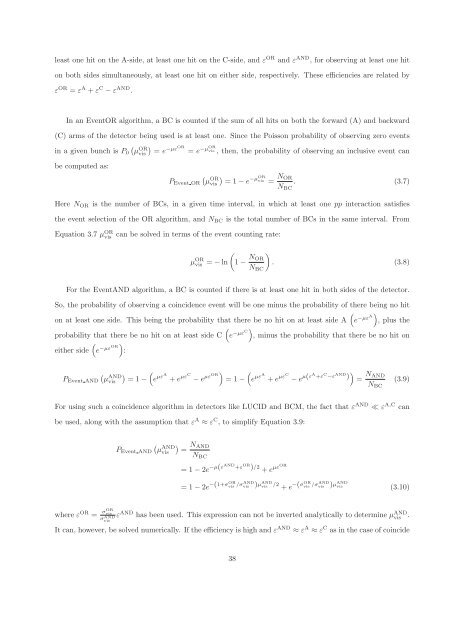CERN-THESIS-2012-153 26/07/2012 - CERN Document Server
CERN-THESIS-2012-153 26/07/2012 - CERN Document Server
CERN-THESIS-2012-153 26/07/2012 - CERN Document Server
You also want an ePaper? Increase the reach of your titles
YUMPU automatically turns print PDFs into web optimized ePapers that Google loves.
least one hit on the A-side, at least one hit on the C-side, and ε OR and ε AND , for observing at least one hit<br />
on both sides simultaneously, at least one hit on either side, respectively. These efficiencies are related by<br />
ε OR = ε A + ε C − ε AND .<br />
In an EventOR algorithm, a BC is counted if the sum of all hits on both the forward (A) and backward<br />
(C) arms of the detector being used is at least one. Since the Poisson probability of observing zero events<br />
<br />
OR −µε in a given bunch is P0 µ vis = e OR<br />
= e−µOR vis , then, the probability of observing an inclusive event can<br />
be computed as:<br />
PEvent OR<br />
OR<br />
−µ<br />
µ vis = 1 − e OR<br />
vis = NOR<br />
. (3.7)<br />
Here NOR is the number of BCs, in a given time interval, in which at least one pp interaction satisfies<br />
the event selection of the OR algorithm, and NBC is the total number of BCs in the same interval. From<br />
Equation 3.7 µ OR<br />
vis<br />
can be solved in terms of the event counting rate:<br />
NBC<br />
µ OR<br />
<br />
vis = −ln 1 − NOR<br />
<br />
. (3.8)<br />
NBC<br />
For the EventAND algorithm, a BC is counted if there is at least one hit in both sides of the detector.<br />
So, the probability of observing a coincidence event will be one minus the probability of there being no hit<br />
<br />
e−µεA, plus the<br />
<br />
e−µεC, minus the probability that there be no hit on<br />
on at least one side. This being the probability that there be no hit on at least side A<br />
probability that there be no hit on at least side C<br />
either side<br />
PEvent AND<br />
<br />
e −µεOR<br />
:<br />
<br />
AND<br />
µ vis = 1 − e µεA<br />
+ e µεC<br />
− e µεOR<br />
<br />
= 1 − e µεA<br />
+ e µεC<br />
− e µ(εA +ε C −ε AND ) <br />
= NAND<br />
NBC<br />
For using such a coincidence algorithm in detectors like LUCID and BCM, the fact that ε AND ≪ ε A,C can<br />
be used, along with the assumption that ε A ≈ ε C , to simplify Equation 3.9:<br />
PEvent AND<br />
AND NAND<br />
µ vis =<br />
NBC<br />
= 1 − 2e −µ(εAND +ε OR )/2 + e µε OR<br />
(3.9)<br />
= 1 − 2e −(1+σOR vis /σAND<br />
vis )µ AND<br />
vis /2 + e −(σOR<br />
vis /σAND<br />
vis )µ AND<br />
vis (3.10)<br />
where εOR = σOR<br />
vis<br />
σAND ε<br />
vis<br />
AND has been used. This expression can not be inverted analytically to determine µ AND<br />
vis .<br />
It can, however, be solved numerically. If the efficiency is high and ε AND ≈ ε A ≈ ε C as in the case of coincide<br />
38















